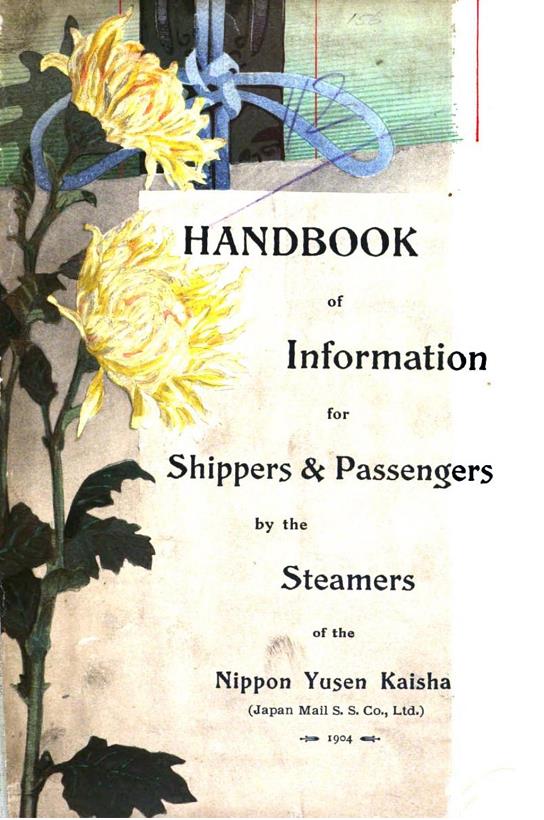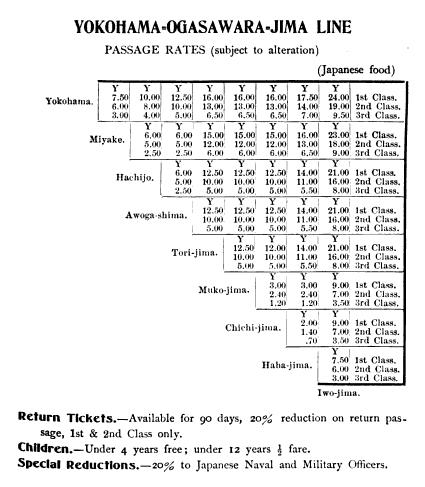|
  |
YOKOHAMA-OGASAWARA-JIMA LINE
Ogasawara-jima is the Japanese name for the group of islands known to Europeans as the "Bonins." The name "Ogasawara" is that of the Japanese feudal chief who discovered the archipelago in the 16th century, and the term "Bonin" is an Occidental corruption of bunin, which, in the Japanese language, signifies "uninhabited." It was not indeed until 1827 that these islands began to have dwellers in the shape of shipwrecked whalers from the Sandwich Islands and other places, who, accompanied by Kanaka wives, established a colony numbering less than fourscore, beyond which total the community did not grow until the second half of the nineteenth century, when (1875) Japan having taken forward possession of the archipelago, her people soon found their way thither, their aggregate being now over six thousand. "The half-caste settlers, who all speak English, remain on as Japanese subjects, undisturbed in their old holdings, and continue to live in cabins thatched with leaves of the cabbage-palm. Many of these men spend the summer months sealing in the North Pacific. Most of the children now attend the Japanese Government schools" (Murray's " Handbook for Japan "). |
On her way to the Bonins the steamer, leaving Yokohama in the afternoon, calls on the following morning at Hachijo-jima, the most southerly of the group known as the "Seven Isles of Izu." This is the island which tradition assigns as the landing-place of the expeditions sent from the Chinese Court in the third century before Christ to search for elysium and the elixer of life. It is also distinguished in Japanese legendary lore as having been formerly inhabited by women only, whose husbands, living on "Demon's Island" some 40 miles to the south, visited Hachijo-jima once yearly when the wind blew from a certain quarter. So far as the pages of history tell, Hachijo-jima was not discovered by the Japanese until the 15th century of the Christian era, a fact which, if trustworthy, goes to indicate that the spirit of maritime enterprise did not animate the nation in mediaeval times. The shores of the island are laved by the Kuro-shiwo, the celebrated "black current," which imparts to the sea a colour of peculiar intensity, and the very pronounced evidences of volcanic activity shown in the configuration of the island render the scenery strange and picturesque. Travellers generally devote the time of the steamer's stay — from the forenoon till the afternoon — making the ascent of the principal volcanic peak, the Fuji of Hachijo, which is at the north-west end of the island and has a height of some 2,900 feet. Leaving Hachijo-jima in the evening, the steamer, on |
the following morning, passes Demon's Island (Awoga-shima or Oniga-shima) spoken of above. She calls there twice in the season — in May and July — and remains from the forenoon until the afternoon. Twice also — namely, in May and July when going south and in June and August when coming north — she puts in at Tori-jima, which is 125 miles south of Hachijo-jima. Tori-jima is remarkable as the scene of a volcanic eruption in the year 1902, which destroyed the whole population of 140 persons and practically obliterated all traces of their habitations. The principal among the Bonin Islands are Chichi-jima (father island) and Haha-jima (mother island). The former, called also "Peel Island," is on the north; and the latter, designated "Bailey Island" (or "Caffin [sic] Island") by English cartographers, is on the south. But the most northerly cluster of the Bonins is the Parry Group, which comprises isles called by the Japanese "Bridegroom Isle " {Muko-jima), "Bride Isle" {Yome-jima) and so forth. Japanese navigators, in short, conceived and carried out the idea of distinguishing the Bonins as essentially a family cluster, so that in the vicinity of Mother Island are smaller isles known as "Sister-isle " (Ane-jima), "Niece Isle" (Mei-jima) etc., while near Father Island lie "Elder Brother Isle" (Ani-jima), "Younger Brother Isle" (Ototo-jima) and so forth. Chichi-jima is 545 miles from |
Yokohama and 230 miles south of Tori-jima. The steamer remains there 2 days in Port Lloyd, which is considered to be the crater of an extinct volcano. She then proceeds to Haha-jima, 35 miles farther south, and remains there a few hours. Once a year, namely, in the month of June, she prolongs her voyage to the "Sulphur Islands" (Iwo-jima), which lie a few miles to the southward. Sugar is the staple product of the Bonin Islands, and in recent years the curing of pine-apples and turtles has grown to be a flourishing industry. At a distance of nearly 650 miles on the south-east of "Mother Island" there is a small speck of land known as Marcus Island, the proprietorship of which threatened in very recent times to become a subject of dispute between the United States of America and Japan. The validity of the latter's title was ultimately recognised in Washington. The round trip from Yokohama to the Bonins (or to the Sulphur Islands farther south) and back again, occupies only a fortnight, and presents many attractions to tourists. In the above remarks no mention has been made of Miyake-jima, one of the Seven Isles of Izu, though it is often the steamer's first port of call after leaving Yokohama and before reaching Hachijo-jima. This omission is due to the fact that the question of touching at Miyake-jima is determined solely by consideration of freight convenience, and no definite statement can be made about it. |
Following is the schedule of fares on the route : —  |
|
Source.
Nippon Yusen Kaisha (Japan Mail S.S. Co., Ltd.)
This transcription was made from a volume at Google Books.
Last updated by Tom Tyler, Denver, CO, USA, Oct 5 2022.
|
|